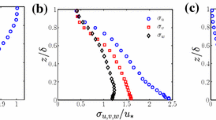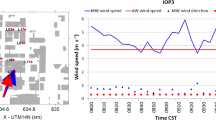Abstract
This study focuses on the influence of emission conditions—velocity and temperature—on the dynamics of a buoyant gas release in the atmosphere. The investigations are performed by means of wind tunnel experiments and numerical simulations. The aim is to evaluate the reliability of a Lagrangian code to simulate the dispersion of a plume produced by pollutant emissions influenced by thermal and inertial phenomena. This numerical code implements the coupling between a Lagrangian stochastic model and an integral plume rise model being able to estimate the centroid trajectory. We verified the accuracy of the plume rise model and we investigated the ability of two Lagrangian models to evaluate the plume spread by means of comparisons between experiments and numerical solutions. A quantitative study of the performances of the models through some suitable statistical indices is presented and critically discussed. This analysis shows that an additional spread has to be introduced in the Lagrangian trajectory equation in order to account the dynamical and thermal effects induced by the source conditions.










Similar content being viewed by others
References
Anfossi D, Ferrero E, Brusasca G, Marzorati A, Tinarelli G (1993) A simple way of computing buoyant plume rise in a Lagrangian stochastic dispersion model for airborne dispersion. Atmos Environ 27A:1443–1451
Anfossi D, Tinarelli G, Nibart M, Olry C, Commanay J (2010) A new Lagrangian particle model for the simulation of dense gas dispersion. Atmos Environ 44:753–762
Arya SPS, Lape JF Jr (1990) A comparative study of the different criteria for the physical modelling of buoyant plume rise in a neutral atmosphere. Atmos Environ 24A:289–295
Berrone S, Marro M (2010) Numerical investigations of effectivity indices of space–time error indicators for Navier–Stokes equations. Comput Methods Appl Mech Eng 199:1764–1782
Bowne NE, Londergan RJ (1983) Overview, results and conclusions for the EPRI plume model validation and development project: plain site. Report EA-3074, EPRI, Palo Alto
Briggs GA (1975) Plume rise predictions. Lectures on air pollution and environmental impact analyses. American Meteorological Society, Boston, pp 72–73
Chang JC, Hanna SR (2004) Air quality performance evaluation. Meteorol Atmos Phys 87:167–196
Contini D, Robins A (2001) Water tank measurements of buoyant plume rise and structure in neutral crossflows. Atmos Environ 35:6105–6115
Contini D, Cesari D, Donateo A, Robins AG (2009) Effects of Reynolds number on stack plume trajectories simulated with small scale models in a wind tunnel. J Wind Eng Ind Aerodyn 97:468–474
Contini D, Donateo A, Cesari D, Robins AG (2011) Comparison of plume rise models against water tank experimental data for neutral and stable crossflows. J Wind Eng Ind Aerodyn 99:539–553
Counihan J (1969) An improved method of simulating an atmospheric boundary layer in a wind tunnel. Atmos Environ 3(2):197–214
Davidson GA (1989) Simultaneous trajectory and dilution predictions from a simple integral plume model. Atmos Environ 23:341–349
Fackrell JE, Robins A (1982) Concentration fluctuations and fluxes in plumes from point sources in a turbulent boundary layer. J Fluid Mech 117:1–26
Gardiner CW (1983) Handbook of stochastic methods for physics chemistry and the natural sciences. Springer, Berlin
Heinz S, Van Dop H (1999) Buoyant plume rise described by a Lagrangian turbulence model. Atmos Environ 33:2031–2043
Hewett TA, Fay JA, Hoult DP (1971) Laboratory experiments of smokestack plumes in a stable atmosphere. Atmos Environ 5:767–789
Irwin H (1981) The design of spires for wind simulation. J Wind Eng Ind Aerodyn 7:361–366
Jirka GH (2004) Integral model for turbulent buoyant jets in unbounded stratified flows. Part I: single round jet. Environ Fluid Mech 4:1–56
Koopman RP, Baker J, Cederwall RT, Coldwire HC, Hogan WJ, Kamppinen LJ, Kiefer RD, McClure JD, McRae TG, Morgan DL, Morris LK, Span MW (1982) BURRO series data report LLNL/NWC 1980 LNG spill tests, report UCID-19075. LLNL, Livermore
Kovalets IV, Maderich VS (2006) Numerical simulation of interaction of the heavy gas cloud with the atmospheric surface layer. Environ Fluid Mech 6:313–340
McQuaid J (1985) Heavy gas dispersion trials at Thorney Island. Elsevier, New York
Michaux G, Vauquelin O (2009) Density effect on the mixing and the flow pattern of an impinging air–helium jet. Exp Therm Fluid Sci 33(6):976–982
Ooms G, Mahieu AP (1981) A comparison between a plume path model and a virtual point source model for a stack plume. Appl Sci Res 36:339–356
Pope SB (1987) Consistency conditions for random-walk models of turbulent dispersion. Phys Fluids 30:2374–2379
Pope SB (2000) Turbulent flows. Cambridge University Press, New York
Poreh M, Kacherginsky A (1981) Simulation of plume rise using small wind tunnel models. J Wind Eng Ind Aerodyn 7:10–14
Raupach MR, Antonia R, Rajoplan S (1981) Rough-wall turbulent boundary layers. Appl Mech Rev 44(1):1–25
Robins AG (1980) Wind tunnel modelling of buoyant emissions. In: Atmospheric pollution. Proceedings of the 14th International Colloquium, Paris
Robins AG, Apsley DD, Carruthers DJ, McHugh CA, Dyster SJ (2009) Plume rise model specification. Technical report, University of Surrey, National Power and CERC
Rooney GG, Linden PF (1996) Similarity considerations for non-Boussinesq plumes in an unstratified environment. J Fluid Mech 318:237–250
Rutledge KW (1984) Wind tunnel modelling of buoyant plumes. University of Oxford, Oxford
Salizzoni P, Soulhac L, Mejean P, Perkins RJ (2008) Influence of a two-scale surface roughness on a neutral turbulent boundary layer. Bound-Layer Meteorol 127:97–110
Schatzmann M (1979) An integral model of plume rise. Atmos Environ 13:721–731
Scorer R (1978) Environmental aerodynamics. Wiley, London
Shahzad K, Fleck BA, Wilson DJ (2007) Small scale modelling of vertical surface jets in cross-flow: Reynolds number and downwash effects. Trans ASME J Fluid Eng 129:311–318
Snyder WH (1981) Guideline for fluid modeling of atmospheric diffusion. U.S. Environmental Protection Agency, Washington, DC
Tenneks H (1982) Similarity relations, scaling laws and spectral dynamics. A course held in The Hague, pp 37–68
Thomson DJ (1987) Criteria of the selection of stochastic models of particle trajectories in turbulent flows. J Fluid Mech 180:529–556
Vendel F, Soulhac L, Mejean P, Donnat L, Duclaux O (2011) Validation of the Safety Lagrangian Atmospheric Model (SLAM) against a wind tunnel experiment over an industrial complex area. In: 14th conference on harmonisation within atmospheric dispersion modelling for regulatory purposes, Kos
Webster HN, Thomson DJ (2002) Validation of a Lagrangian model plume rise scheme using the Kincaid data set. Atmos Environ 36:5031–5042
Wilson JD, Sawford BL (1996) Review of Lagrangian stochastic models for trajectories in the turbulent atmosphere. Bound-Layer Meteorol 78:191–210
Acknowledgments
The authors would like to express their gratitude to the laboratory expertise of Christian Nicot.
Author information
Authors and Affiliations
Corresponding author
Appendix
Appendix
The evaluation of the accuracy of a model requires defining some parameters in order to quantify the differences between numerical solutions and experimental data. In this study we have applied the criteria proposed by Chang and Hanna [7]. The global error is split into a systematic error and a local error. The first is related to the general ability of the model to underestimate or overestimate the measures. The second provides an evaluation of the differences between the single predictions and the mean behaviour of the model. The systematic and local errors are evaluated by the AFB and the NMSE, respectively:
where \(C_{exp} (j)\) and \(C_{mod} (j)\) are, respectively, the experimental measure and the computed value evaluated at each measure point \(j\) and for each plume \(i\); \(N\) and \(M\) are the number of measurements and the number of plumes, respectively.
If the data are distributed on several orders of magnitude, AFB and NMSE give a larger weight to the higher values. In order to balance this effect we define two logarithmic indices, the MG for the systematic error and the VG for the local error:
The fraction of observations within a FAC2 is related to the ability of the model to provide results without exceeding an upper bound. The FAC2 is defined as the fraction of data having the property \(0.5\le C_{exp} /C_{mod} \le 2\).
The criterion of acceptance of the model performances is provided by the validity ranges of the statistical indices [7]:
-
\(FAC2\ge 0.5;\)
-
\(AFB\le 0.3;\)
-
\(0.7\le MG\le 1.3;\)
-
\(NMSE\le 1.5;\)
-
\(VG\le 4.0.\)
Rights and permissions
About this article
Cite this article
Marro, M., Salizzoni, P., Cierco, F.X. et al. Plume rise and spread in buoyant releases from elevated sources in the lower atmosphere. Environ Fluid Mech 14, 201–219 (2014). https://doi.org/10.1007/s10652-013-9300-9
Received:
Accepted:
Published:
Issue Date:
DOI: https://doi.org/10.1007/s10652-013-9300-9




